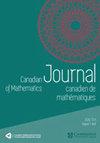On the general dyadic grids on ${\mathbb {R}}^d$
IF 0.7
3区 数学
Q3 MATHEMATICS
Canadian Journal of Mathematics-Journal Canadien De Mathematiques
Pub Date : 2022-07-08
DOI:10.4153/S0008414X22000360
引用次数: 1
Abstract
Abstract Adjacent dyadic systems are pivotal in analysis and related fields to study continuous objects via collections of dyadic ones. In our prior work (joint with Jiang, Olson, and Wei), we describe precise necessary and sufficient conditions for two dyadic systems on the real line to be adjacent. Here, we extend this work to all dimensions, which turns out to have many surprising difficulties due to the fact that $d+1$ , not $2^d$ , grids is the optimal number in an adjacent dyadic system in $\mathbb {R}^d$ . As a byproduct, we show that a collection of $d+1$ dyadic systems in $\mathbb {R}^d$ is adjacent if and only if the projection of any two of them onto any coordinate axis are adjacent on $\mathbb {R}$ . The underlying geometric structures that arise in this higher-dimensional generalization are interesting objects themselves, ripe for future study; these lead us to a compact, geometric description of our main result. We describe these structures, along with what adjacent dyadic (and n-adic, for any n) systems look like, from a variety of contexts, relating them to previous work, as well as illustrating a specific exa.${\mathbb {R}}^d$上的一般二元网格
相邻二进系统是分析和相关领域中通过二进系统的集合来研究连续对象的关键。在我们之前的工作中(与Jiang, Olson和Wei联合),我们描述了实线上两个并矢系统相邻的精确充分必要条件。在这里,我们将这项工作扩展到所有维度,结果发现有许多令人惊讶的困难,因为$d+1$,而不是$2^d$,网格是$\mathbb {R}^d$中相邻二进系统中的最优数。作为一个副产品,我们证明了$\mathbb {R}^d$中的$d+1$二进系统的集合是相邻的当且仅当其中任意两个在$\mathbb {R}$上的投影相邻。在这种高维概括中出现的潜在几何结构本身就是有趣的对象,适合未来的研究;这些使我们得到了对主要结果的简洁的几何描述。我们从各种上下文描述这些结构,以及相邻的二进(和n进,对于任何n)系统是什么样子,将它们与以前的工作联系起来,并举例说明一个特定的例子。
本文章由计算机程序翻译,如有差异,请以英文原文为准。
求助全文
约1分钟内获得全文
求助全文
来源期刊
CiteScore
1.80
自引率
0.00%
发文量
58
审稿时长
4.5 months
期刊介绍:
The Canadian Journal of Mathematics (CJM) publishes original, high-quality research papers in all branches of mathematics. The Journal is a flagship publication of the Canadian Mathematical Society and has been published continuously since 1949. New research papers are published continuously online and collated into print issues six times each year.
To be submitted to the Journal, papers should be at least 18 pages long and may be written in English or in French. Shorter papers should be submitted to the Canadian Mathematical Bulletin.
Le Journal canadien de mathématiques (JCM) publie des articles de recherche innovants de grande qualité dans toutes les branches des mathématiques. Publication phare de la Société mathématique du Canada, il est publié en continu depuis 1949. En ligne, la revue propose constamment de nouveaux articles de recherche, puis les réunit dans des numéros imprimés six fois par année.
Les textes présentés au JCM doivent compter au moins 18 pages et être rédigés en anglais ou en français. C’est le Bulletin canadien de mathématiques qui reçoit les articles plus courts.

 求助内容:
求助内容: 应助结果提醒方式:
应助结果提醒方式:


